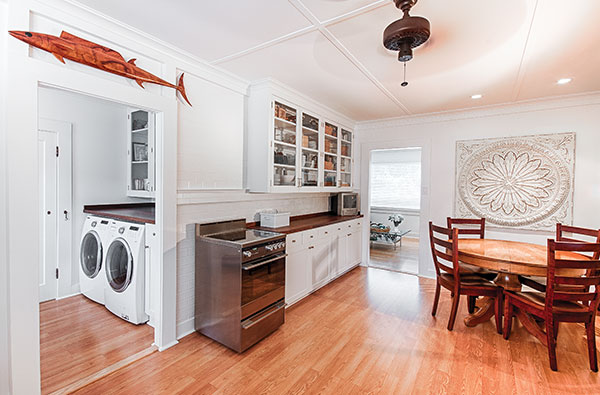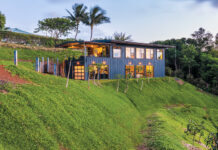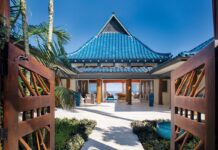Story by Heidi Pool | Photography courtesy of Marshall Design Studio, LLC

Most people hire a home inspector to find out whether or not a house is well built. Jane Ornellas Marshall uses her nose. “You can smell when it’s a good house,” she says.
Jane’s keen olfactory perception came in handy in 2006, when she spent a day looking at real estate with agent Robert Horcajo. “We looked at several properties in Makawao and Wailuku,” she recalls, “but none of them seemed viable.” Until they entered an unassuming 1940s-era bungalow in Wailuku’s Old Sand Hills neighborhood, that is. “I knew right away I could successfully renovate the house,” she says. Just to be certain, Jane crawled under the dwelling and climbed into the attic, inhaling deeply in each space. “The entire place smelled clean and dry,” she says. “And I detected the deep, rich aroma of old-growth wood.”
A professional interior designer, Jane whipped out her tape measure and collected the dimensions of every room, then sketched a quick diagram at the kitchen counter. “I used my crude drawing to create a rough floor plan,” she says. “After two hours of sketching, I knew it would work.”
A fourth-generation Mauian, Jane headed to New York to pursue a design career after graduating from St. Anthony Junior-Senior High School. She worked with architectural firms in New York City, Honolulu and San Francisco. But when her grandmother died, and her relatives sold the home in Kahului that had been the family’s main gathering place, Jane decided to reestablish her connection to Maui.
Jane and her architect husband, Gary, purchased the Sand Hills bungalow in 2006, and used it as a rental property until 2011, when circumstances enabled them to take on the extensive renovation. Gary was working in San Francisco at the time, so Jane handled the remodel herself — with his long-distance advice. “I served as general contractor,” she says. Because Jane wanted to restore as much of the original wooden doors, cabinetry, and windows as possible, she turned to David Powell, a master woodworker who became project manager and lead carpenter.

And restore the woodwork they did. “Wooden double-hung windows are a large part of the charm of older homes,” says Jane. Over time, they also tend to become stubborn about opening and closing. Jane and David cleaned and reused the original lift weights; replaced the ropes; repaired, sanded, and repainted the windows — which all operate effortlessly now.
Jane stripped and painted all the interior doors. “I also removed the old hardware and crystal doorknobs,” she says. “When I disassembled the brass mortise boxes, I photographed them so I’d remember where every little piece went. They were more than sixty years old; I went through bottles and bottles of Brasso Metal Polish!”
The home’s interior mainly needed a cosmetic upgrade. “We added new trim and cabinetry to match the existing,” Jane says. For the new doors and cabinetry, she and David obtained solid brass hardware from restoration suppliers to complement the original design. They also painted all the walls white. “When we bought the house, every room was a different color,” says Jane. “Gary and I intend to stay here for a long time, and white never goes out of fashion.”

They retained the home’s original hardwood flooring, and replaced the dated linoleum in the kitchen and laundry with as close a match to the original wood as they could find. They also completed an addition begun by the previous owner; it’s now a home office.
Outside was another story, says Jane. “We first had to remove some ‘accessory structures’”: a lean-to carport, a poorly constructed deck, and a huge purple plastic hot tub in the backyard. With those items gone, Jane and David began renovating the exterior. The original siding contained asbestos. They had it all removed and disposed of by an approved abatement contractor, repaired termite and water damage, and installed HardieShingle siding, a fairly indestructible fiber cement that looks like cedar.
“A lot of homeowners here choose vertical plank siding, which was common in the plantation era,” says Jane. “But Gary and I like the look of shake siding. It lends what I call a ‘Hawaiian-Yankee’ architectural quality. The house’s scale, symmetries, spareness, and choice of materials are similar to what you see around Nantucket or Cape Cod, while the high-pitched roofline was influenced by indigenous thatched roofs found in the Islands.”
This roof, however, is new. The old one — three layers laid one on top of another — had deteriorated so badly that the roofer wouldn’t go up even to inspect it. Jane had it replaced with a new shingle system rated for wind speeds up to 130 miles per hour. (She ruefully admits she may have been overly concerned about the wind.) She also added energy-efficient reflective sheathing and roof-deck protection.
Jane and David installed new rafter tail extensions under the eaves, creating a deeper and more consistent roof overhang for better protection from the elements, and a clean, crisp appearance. “Leaving the tail ends exposed is traditional in plantation architecture,” says Jane. “Rather than covering them with fascia board or gutters, we placed copper flashing and drip edges above both lanais to divert rainwater.”
Seen from the street, Jane and Gary’s home looks fairly modest. From the backyard, it appears quite grand. Much of that impression is attributable to the cozy, covered lanai that extends from the living room. One can easily imagine whiling away an afternoon there, sipping iced tea, and gazing at the magnificent mango trees that shade the yard.
“David and I rebuilt the lanai’s rails and posts,” Jane says. “They were modeled after the porch-rail detail at Hali‘imaile General Store. I’d long admired that porch for its simple, functional design.”

The Marshalls completed the renovation in Spring 2012. The following year, the home garnered a Design Excellence Award from the Hawai‘i Chapter of the American Society of Interior Designers. It also won a Preservation Award from the Historic Hawai‘i Foundation. In a letter to the Marshalls announcing the latter, foundation Executive Director Kiersten Faulkner states: “This project is a good example of great efforts being put into preservation and rehabilitation of a historical residence.”
“Being recognized by the Historic Hawai‘i Foundation validates our efforts,” Jane says. “Gary and I hope our project will influence others who love older homes to do the same. These classic homes are an important part of our island’s architectural heritage, and we believe rebuilding old neighborhoods, instead of creating more suburban sprawl, is the ultimate example of sustainability.”
It was only after Gary and Jane moved into the home that they learned a surprising part of its history. Neighbors told them that the original owners were Masa and Florence Shimoda, who built the house in 1948 and lived there all their adult lives. The Shimodas had owned a traditional Japanese store at the corner of Ka‘ahumanu and Pu‘unene Avenues in Kahului from the 1940s until a tidal wave flooded the area in 1960. Perhaps as zealously cautious over tsunamis as Jane would later be about wind, the Shimodas decided to relocate their business to higher ground, and established the Hali‘imaile General Store in Upcountry Maui. In the late 1980s, now-celebrity chef Beverly Gannon purchased that building from the Shimodas, remodeled it, and opened her award-winning restaurant of the same name. “I think the Shimodas would be proud to know they left behind two buildings their future owners treasured enough to restore,” says Jane.





